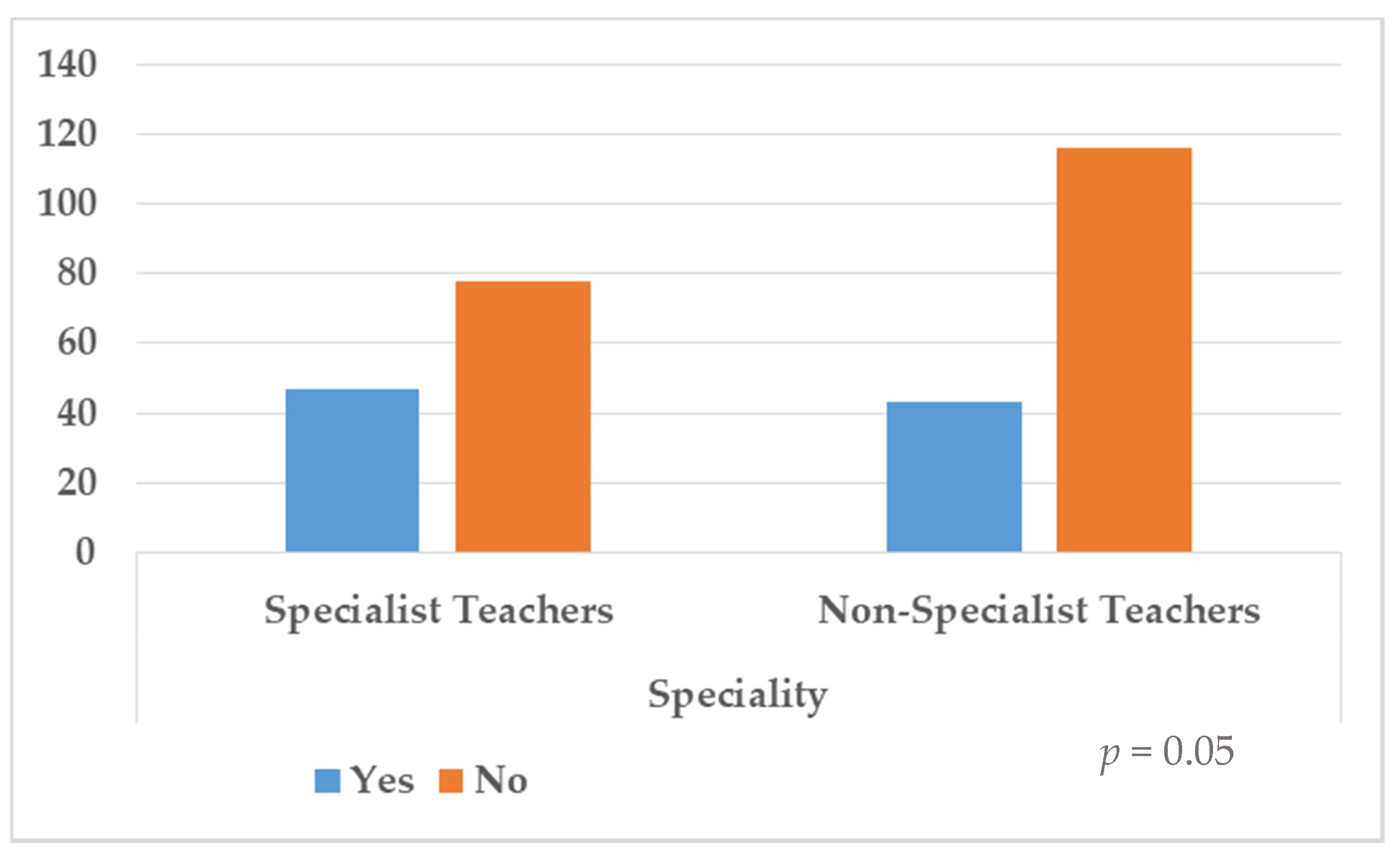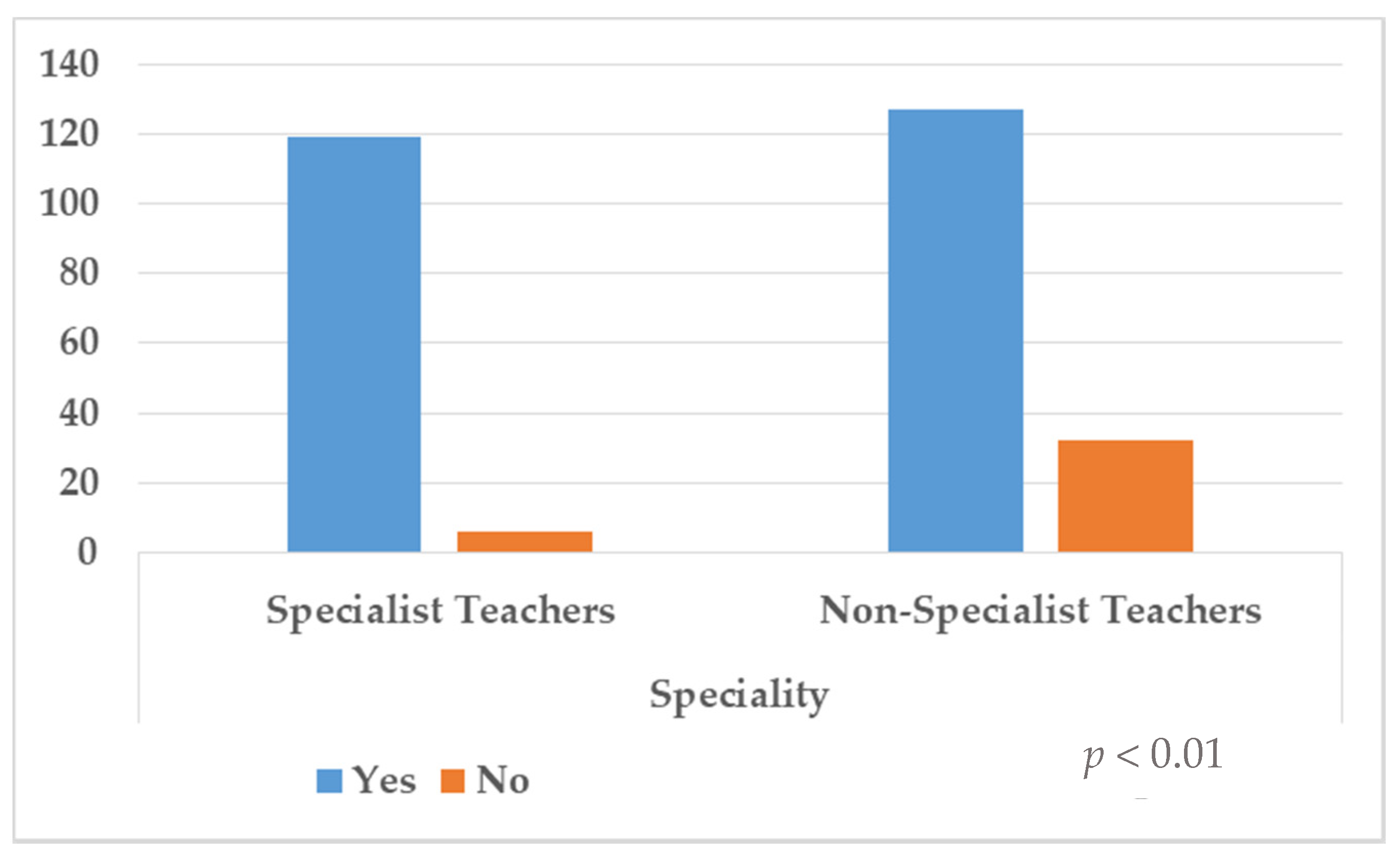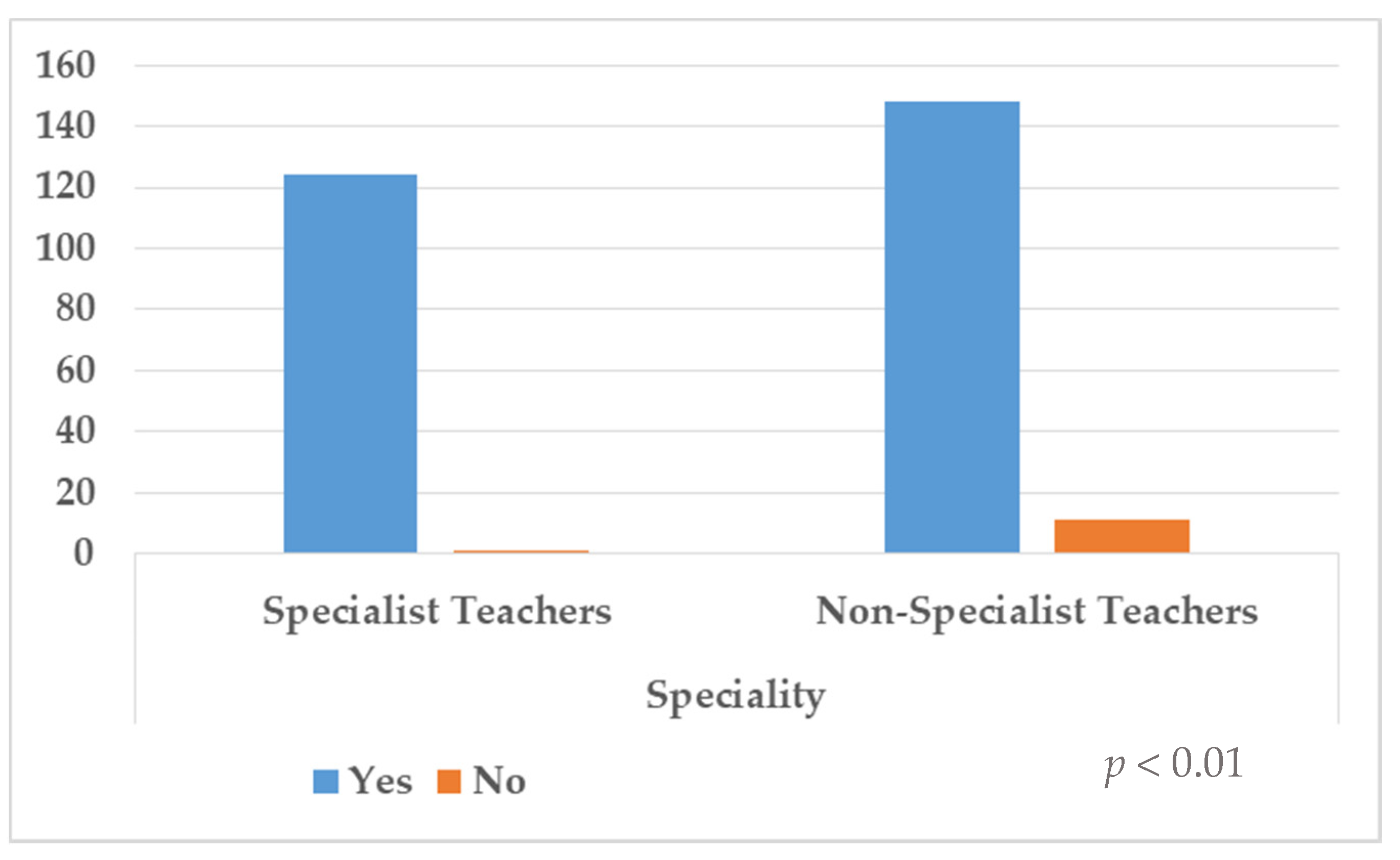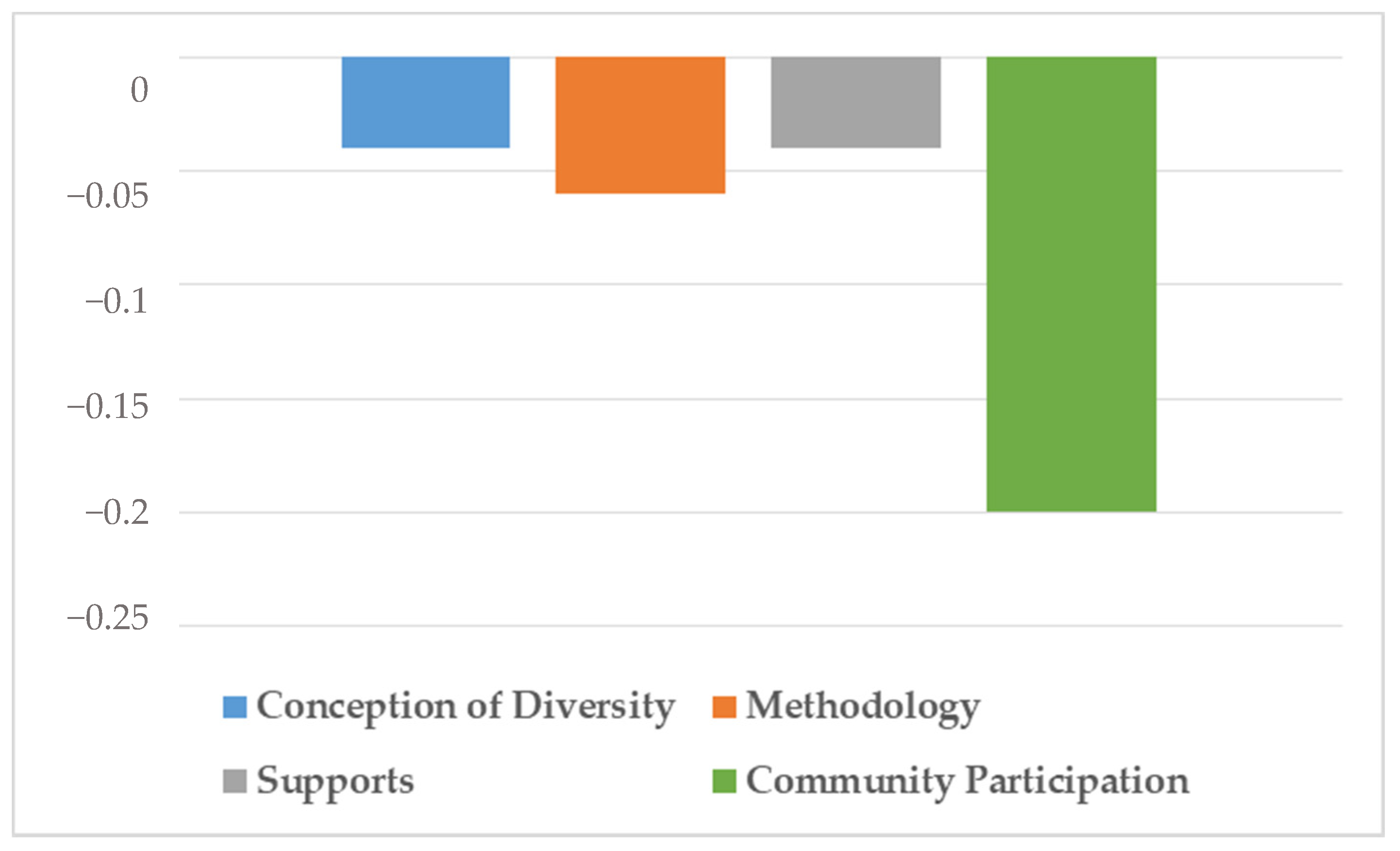A Descriptive Study of Specialist and Non-Specialist Teachers’ Preparation towards Educational Inclusion
Abstract
1. Introduction
2. Materials and Methods
2.1. Participants
2.2. Instruments
2.3. Procedure
2.4. Statistical Analysis
3. Results
3.1. The Three Questions Results
3.2. The CEFI-R Questionnaire Results
3.3. Correlations between the CEFI-R Questionnaire and Age and Reliability
4. Discussion
5. Conclusions
Author Contributions
Funding
Institutional Review Board Statement
Informed Consent Statement
Data Availability Statement
Acknowledgments
Conflicts of Interest
Appendix A
| 1 | Preferiría no tener en mi aula alumnos con necesidades específicas de apoyo educativo |
| 2 | Un niño con necesidades específicas de apoyo educativo interrumpe la rutina del aula y perjudica el aprendizaje de sus compañeros |
| 3 | No debemos escolarizar alumnos con necesidades educativas especiales en centros ordinarios hasta que no tengamos la formación adecuada para ello |
| 4 | Los alumnos con necesidad específica de apoyo educativo no pueden seguir el día a día del curriculum |
| 5 | Me preocupa que mi carga de trabajo se incremente si tengo alumnos con necesidades específicas de apoyo educativo en mi clase |
| 6 | Sé cómo enseñar a cada uno de mis alumnos de manera diferente en función de sus características individuales |
| 7 | Sé cómo elaborar las unidades didácticas y las clases teniendo presente la diversidad de los estudiantes |
| 8 | Sé cómo adaptar mi forma de evaluar a las necesidades individuales de cada uno de mis alumnos |
| 9 | Sé cómo manejar y adaptar los materiales didácticos para responder a las necesidades de cada uno de mis alumnos |
| 10 | Soy capaz de adaptar mis técnicas de comunicación para asegurarme de que todos los alumnos puedan ser incluidos con éxito en el aula ordinaria |
| 11 | La planificación conjunta profesor-profesor de apoyo facilitaría que los apoyos se proporcionaran dentro del aula |
| 12 | Creo que la mejor manera de proporcionar apoyo a los alumnos es que el profesor de apoyo se incorpore al aula, en lugar de hacerlo en el aula de apoyo |
| 13 | La función del profesor de apoyo es trabajar con todo el alumnado de mi aula |
| 14 | Considero que el lugar del profesor de apoyo está dentro del aula ordinaria con cada uno de los profesores |
| 15 | El proyecto educativo debería revisarse con la participación de los distintos agentes de la comunidad educativa (profesores, padres, alumnos...) |
| 16 | Es fundamental que haya una relación muy estrecha entre el profesorado y el resto de agentes educativos (AMPA, asociación de vecinos, consejo escolar...) |
| 17 | La escuela debe fomentar la implicación de los padres y de la comunidad |
| 18 | Cada miembro del centro educativo (profesores, padres, alumnos, otros profesionales) es un elemento fundamental del mismo |
| 19 | El centro debe trabajar de forma conjunta con los recursos del barrio (biblioteca, servicios sociales, servicios sanitarios...) |
References
- Durán Gisbert, D.; Climent, G.G. La Formación del Profesorado para la Educación Inclusiva: Un Proceso de Desarrollo Profesional y de Mejora de los Centros para Atender la Diversidad. 2017. Available online: http://repositoriocdpd.net:8080/handle/123456789/1913 (accessed on 1 April 2021).
- Varela, E.V.; Portela Pino, I.; Rodríguez, V.D. Attention to Diversity in Compulsory Secondary Education. Eur. J. Investig. Health Psychol. Educ. 2020, 10, 1176–1185. [Google Scholar] [CrossRef]
- Al Zyoudi, M.; Al Sartwai, A.; Dodin, H. Attitudes of pre-service teachers towards inclusive education in UAE and Jordan (a comparative study). Int. J. Disabil. Community Rehabil. 2011, 10, 1063–1084. [Google Scholar]
- Rojo-Ramos, J.; Ferrera-Granados, C.; Fernández-Guerrero, M.; Manzano-Redondo, F.; Garcia-Gordillo, M.A.; Polero, P.; Adsuar, J.C. A descriptive study on the training and attitude of future teachers towards educational inclusion. Sustainability 2020, 12, 8028. [Google Scholar] [CrossRef]
- Consellería de Educación e Ordenación Universitaria de Galicia. Catálogo de Validacións 2005–2006. Acceso a Estudios Universitarios desde a Formación Profesional de Grao Superior. 2007. Available online: http://vicoap.webs.uvigo.es/validacions_FP/files/validacions_FP_univ_0506.pdf (accessed on 3 April 2021).
- Biedma Aguilera, P.E.; Moya Maya, A. La intervención del Profesorado de Apoyo a la Integración dentro del aula ordinaria en Huelva capital: Hacia una escuela inclusiva. Rev. Educ. Inclusiva 2015, 8, 153–170. [Google Scholar]
- Muntaner, J.J. Los Apoyos Facilitadores para la Inclusión. 2014. Available online: http://www.quadernsdigitals net/index.php (accessed on 5 April 2021).
- Subban, P.; Mahlo, D. ‘My attitude, my responsibility’ Investigating the attitudes and intentions of pre-service teachers toward inclusive education between teacher preparation cohorts in Melbourne and Pretoria. Int. J. Incl. Educ. 2017, 21, 441–461. [Google Scholar] [CrossRef]
- Salas Labayen, M.R. Reflexiones en torno a los maestros de pedagogía terapéutica. Padres Maest. 2016, 6–11. [Google Scholar] [CrossRef][Green Version]
- De la Rosa, A.L.; Cáceres, R.G.; Martínez, J.J.C. Análisis de las concepciones de los futuros profesionales de la educación de la universidad de Almería sobre la atención al alumnado en audición y lenguaje. Profr. Rev. Currículum Form. Profr. 2018, 22, 133–157. [Google Scholar]
- Eisenman, L.T.; Pleet, A.M.; Wandry, D.; McGinley, V. Voices of special education teachers in an inclusive high school: Redefining responsibilities. Remedial Spec. Educ. 2011, 32, 91–104. [Google Scholar] [CrossRef]
- Ilias, V.; Spyros, K.; Dimitriadou, I. The Perceptions of Primary Education Teachers about Inclusive Education in the Greek Educational System. Eur. J. Educ. Stud. 2021, 8. [Google Scholar] [CrossRef]
- Luque, A.; Carrión, J.J. The teacher of hearing and language: An analysis of their itinerant model. Eur. J. Investig. Health Psychol. Educ. 2011, 1, 95–103. [Google Scholar] [CrossRef]
- Round, P.N.; Subban, P.K.; Sharma, U. ‘I don’t have time to be this busy.’ Exploring the concerns of secondary school teachers towards inclusive education. Int. J. Incl. Educ. 2016, 20, 185–198. [Google Scholar] [CrossRef]
- Saloviita, T.; Schaffus, T. Teacher attitudes towards inclusive education in Finland and Brandenburg, Germany and the issue of extra work. Eur. J. Spec. Needs Educ. 2016, 31, 458–471. [Google Scholar] [CrossRef]
- Alba, B.G.; González, P.C.; Olmo, M.M. La inclusión educativa a través de la narrativa-biográfica. Experiencias del profesorado de pedagogía terapeútica. Rev. Infanc. Educ. Aprendiz. 2020, 6, 19–36. [Google Scholar]
- De Boer, A.; Pijl, S.J.; Minnaert, A. Regular primary schoolteachers’ attitudes towards inclusive education: A review of the literature. Int. J. Incl. Educ. 2011, 15, 331–353. [Google Scholar] [CrossRef]
- Pérez-Gutiérrez, M.; Castanedo-Alonso, J.M.; Salceda-Mesa, M.; Cobo-Corrales, C. Scientific production on inclusive education and physical education: A bibliometric analysis. Int. J. Incl. Educ. 2021. [Google Scholar] [CrossRef]
- Salkind, N.J. Métodos de Investigación; Prentice Hall: México, DF, Mexico, 1999. [Google Scholar]
- González-Gil, F.; Martín-Pastor, E.; Baz, B.O.; Castro, R.P. Development and validation of a questionnaire to evaluate teacher training for inclusion: The CEFI-R. Aula Abierta 2019, 48, 229–238. [Google Scholar] [CrossRef]
- Anderson, T.; Kanuka, H. e-Research: Methods, Strategies, and Issues; Allyn & Bacon: Boston, MA, USA, 2002. [Google Scholar]
- Nunnally, J.; Bernstein, I. Elements of statistical description and estimation. Psychom. Theory 1994, 3, 127. [Google Scholar]
- Gómez-Zepeda, G.; Petreñas, C.; Sabando, D.; Puigdellívol, I. The role of the Support and Attention to Diversity Teacher (SADT) from a community-based perspective: Promoting educational success and educational inclusion for all. Teach. Teach. Educ. 2017, 64, 127–138. [Google Scholar] [CrossRef][Green Version]
- Gurgur, H.; Uzuner, Y. Examining the implementation of two co-teaching models: Team teaching and station teaching. Int. J. Incl. Educ. 2011, 15, 589–610. [Google Scholar] [CrossRef]
- Strogilos, V.; Stefanidis, A.; Tragoulia, E. Co-teachers’ attitudes towards planning and instructional activities for students with disabilities. Eur. J. Spec. Needs Educ. 2016, 31, 344–359. [Google Scholar] [CrossRef]
- Sharma, U.; Jacobs, D.K. Predicting in-service educators’ intentions to teach in inclusive classrooms in India and Australia. Teach. Teach. Educ. 2016, 55, 13–23. [Google Scholar] [CrossRef]
- Rodríguez-Gómez, D.; Armengol, C.; Meneses, J. La Adquisición de las Competencias Profesionales a Través de las Prácticas Curriculares de la Formación Inicial de Maestros; Ministerio de Educación: Madrid, Spain, 2017.
- Majoko, T. Teacher key competencies for inclusive education: Tapping pragmatic realities of Zimbabwean special needs education teachers. SAGE Open 2019, 9, 2158244018823455. [Google Scholar] [CrossRef]
- Benavides-Lara, M.A. Flexibilizar el currículum de las Instituciones de Educación Superior (IES) en un entorno de complejidad: Un análisis de casos desde la perspectiva cultural del socio-constructivismo. Voces Silencios. Rev. Latinoam. Educ. 2015, 6, 3–21. [Google Scholar] [CrossRef]
- Duk, C.; Loren, C. Flexibilización del currículum para atender la diversidad. Rev. Latinoam. Inclusión Educ. 2010, 4, 187–210. [Google Scholar]
- Solís García, P.; Borja González, V. Actitudes del profesorado de Educación Física hacia la inclusión de alumnos con discapacidad. Retos Nuevas Tend. Educ. Física Deporte Recreación 2021. [Google Scholar] [CrossRef]
- Tuncay, A.A.; Kizilaslan, A. Pre-service teachers’ sentiments, attitudes and concerns about inclusive education in Turkey. Eur. J. Spec. Needs Educ. 2021. [Google Scholar] [CrossRef]
- González-Rojas, Y.; Triana-Fierro, D.A. Actitudes de los docentes frente a la inclusión de estudiantes con necesidades educativas especiales. Educ. Educ. 2018, 21, 200–218. [Google Scholar] [CrossRef]
- Luna, M.; Martín, E. La importancia de las concepciones en el asesoramiento psicopedagógico. Profr. Rev. Currículum Form. Profr. 2008, 12, 1–12. [Google Scholar]
- Orozco, I.; Moriña, A. Prácticas docentes para una pedagogía inclusiva en educación primaria: Escuchando las voces del profesorado. Aula Abierta 2019, 48, 331–338. [Google Scholar] [CrossRef]
- I Ballús, E.B.; Muñoz, M.T.B.; Dieste, I.B.; i Buron, N.B.; Bonet, M.R.C.; Carvajal, L.C.; César, M.S.; Bayo, C.C.; Reixach, M.C.; Mateu, R.C. Estrategias Organizativas de Aula: Propuestas para Atender la Diversidad; Grao: Barcelona, Spain, 2001; Volume 8. [Google Scholar]
- Barón Mora, A.T.; Cuevas Martínez, C.A.; Rojas Sáenz, P.A.; Moreno Cely, C.P.; Romero Barón, A.M. Experiencias y evolución de los procesos de educación inclusiva. Educ. Cienc. 2020. [Google Scholar] [CrossRef]
- Done, E. Government Policy around Inclusive Education in the UK and the Implications for Children, Families and Teachers. 2020. Available online: https://pearl.plymouth.ac.uk/handle/10026.1/16142 (accessed on 10 April 2021).
- Salinas, S.S. Atención a la Diversidad: Necesidades Educativas: Guía de Actuación para Docentes; Ideaspropias Editorial SL: Vigo, Spain, 2010. [Google Scholar]
- Rodríguez Fuentes, A.; Gallego Ortega, J.L.; Navarro Rincón, A.; Caurcel Cara, M.J. Perspectivas actitudinales de docentes en ejercicio y en formación hacia la educación inclusiva. Psicoperspectivas 2021, 20. [Google Scholar] [CrossRef]
- Garrote, P.R.; del Carmen Rojas, M. La validación por juicio de expertos: Dos investigaciones cualitativas en Lingüística aplicada. Rev. Nebrija Lingüística Apl. Enseñanza Leng. 2015, 18, 124–139. [Google Scholar]
- Carballo, R.; Morgado, B.; Cortés-Vega, M.D. Transforming faculty conceptions of disability and inclusive education through a training programme. Int. J. Incl. Educ. 2021, 25, 843–859. [Google Scholar] [CrossRef]




| Variable | Categories | N | % |
|---|---|---|---|
| Sex | Men | 57 | 20.1 |
| Women | 227 | 79.9 | |
| Age | Under 30 | 19 | 6.7 |
| Between 30 and 40 | 116 | 40.8 | |
| Between 41 and 50 | 98 | 34.5 | |
| Over 50 | 51 | 18 | |
| University degree and specialism | Primary Education (Non-specialists) | 159 | 56 |
| Primary Education (Therapeutic Pedagogy) | 79 | 27.8 | |
| Primary Education (Hearing and Speech) | 46 | 16.2 | |
| Province of the school | Cáceres | 65 | 22.9 |
| Badajoz | 219 | 77.1 | |
| Teacher position | Contract teacher position | 89 | 31.3 |
| Permanent teacher position | 195 | 68.7 | |
| Years of experience | 14.20 (mean) | 9.30 (sd) |
| “My initial preparation prepared me to respond to the diversity diversity of my students needs” | |||||
| Yes | No | p-Value | |||
| Specialism | Specialist teachers | N | 47 | 78 | 0.0 |
| % | 52.2 | 40.2 | |||
| Non-Specialist teachers | N | 43 | 116 | ||
| % | 47.8 | 59.8 | |||
| Total | N | 90 | 194 | ||
| % | 31.7 | 68.3 | |||
| “Ongoing preparation over the years has prepared me to respond to the diversity of my students needs” | |||||
| Yes | No | p-Value | |||
| Specialism | Specialist teachers | N | 119 | 6 | <0.01 |
| % | 48.4 | 15.8 | |||
| Non-Specialist teachers | N | 127 | 32 | ||
| % | 51.6 | 84.2 | |||
| Total | N | 246 | 38 | ||
| % | 86.6 | 13.4 | |||
| “If I were offered inclusive preparation in this respect, I would attend.” | |||||
| Yes | No | p-Value | |||
| Specialism | Specialist teachers | N | 124 | 1 | 0.01 |
| % | 45.6 | 8.3 | |||
| Non-Specialist teachers | N | 148 | 11 | ||
| % | 54.4 | 91.7 | |||
| Total | N | 272 | 12 | ||
| % | 95.8 | 4.2 | |||
| Specialism | ||||
|---|---|---|---|---|
| Item | Total | Specialist Teachers | Non-Specialist Teachers | |
| Me (IQR) | Me (IQR) | Me (IQR) | p-Value | |
| 4 (1) | 4 (0) | 4 (1) | <0.01 |
| 4 (1) | 4 (1) | 3 (2) | <0.01 |
| 4 (1) | 4 (1) | 3 (2) | <0.01 |
| 3 (1) | 3 (1) | 3 (2) | <0.01 |
| 4 (1) | 4 (1) | 3 (2) | <0.01 |
| 3 (2) | 4 (1) | 3 (1) | <0.01 |
| 3 (2) | 4 (1) | 3 (2) | <0.01 |
| 3 (1) | 4 (1) | 3 (2) | <0.01 |
| 3 (1) | 4 (1) | 3 (2) | <0.01 |
| 3 (1) | 4 (1) | 3 (2) | <0.01 |
| 4 (1) | 4 (1) | 4 (1) | 0.01 |
| 3 (2) | 3 (2) | 3 (2) | 0.38 |
| 2 (2) | 2 (1) | 2 (2) | <0.01 |
| 3 (2) | 3 (2) | 3 (2) | 0.80 |
| 4 (1) | 4 (1) | 3 (2) | <0.01 |
| 4 (1) | 4 (1) | 4 (1) | <0.01 |
| 4 (1) | 4 (1) | 4 (1) | 0.16 |
| 4 (0) | 4 (0) | 4 (1) | 0.13 |
| 4 (1) | 4 (1) | 4 (1) | 0.12 |
| Specialism | ||||
|---|---|---|---|---|
| Dimensions | Total Me (IQR) | Specialist Teachers | Non-Specialist Teachers | p |
| 3.4 (1) | 3.6 (0.8) | 3 (1.2) | <0.01 |
| 3 (1.2) | 3.6 (1) | 3 (1) | <0.01 |
| 2.4 (0.8) | 2.4 (0.8) | 2.4 (1) | 0.13 |
| 3.8 (0.8) | 4 (0.4) | 3.6 (1) | <0.01 |
| Dimensions | Age ρ (p) |
|---|---|
| Conception of diversity | −0.04 (0.61) |
| Methodology | −0.06 (0.44) |
| Supports | −0.04 (0.58) |
| Community Participation | −0.20 (<0.01) |
Publisher’s Note: MDPI stays neutral with regard to jurisdictional claims in published maps and institutional affiliations. |
© 2021 by the authors. Licensee MDPI, Basel, Switzerland. This article is an open access article distributed under the terms and conditions of the Creative Commons Attribution (CC BY) license (https://creativecommons.org/licenses/by/4.0/).
Share and Cite
Rojo-Ramos, J.; Manzano-Redondo, F.; Barrios-Fernandez, S.; Garcia-Gordillo, M.A.; Adsuar, J.C. A Descriptive Study of Specialist and Non-Specialist Teachers’ Preparation towards Educational Inclusion. Int. J. Environ. Res. Public Health 2021, 18, 7428. https://doi.org/10.3390/ijerph18147428
Rojo-Ramos J, Manzano-Redondo F, Barrios-Fernandez S, Garcia-Gordillo MA, Adsuar JC. A Descriptive Study of Specialist and Non-Specialist Teachers’ Preparation towards Educational Inclusion. International Journal of Environmental Research and Public Health. 2021; 18(14):7428. https://doi.org/10.3390/ijerph18147428
Chicago/Turabian StyleRojo-Ramos, Jorge, Fernando Manzano-Redondo, Sabina Barrios-Fernandez, Miguel A. Garcia-Gordillo, and Jose Carmelo Adsuar. 2021. "A Descriptive Study of Specialist and Non-Specialist Teachers’ Preparation towards Educational Inclusion" International Journal of Environmental Research and Public Health 18, no. 14: 7428. https://doi.org/10.3390/ijerph18147428
APA StyleRojo-Ramos, J., Manzano-Redondo, F., Barrios-Fernandez, S., Garcia-Gordillo, M. A., & Adsuar, J. C. (2021). A Descriptive Study of Specialist and Non-Specialist Teachers’ Preparation towards Educational Inclusion. International Journal of Environmental Research and Public Health, 18(14), 7428. https://doi.org/10.3390/ijerph18147428










